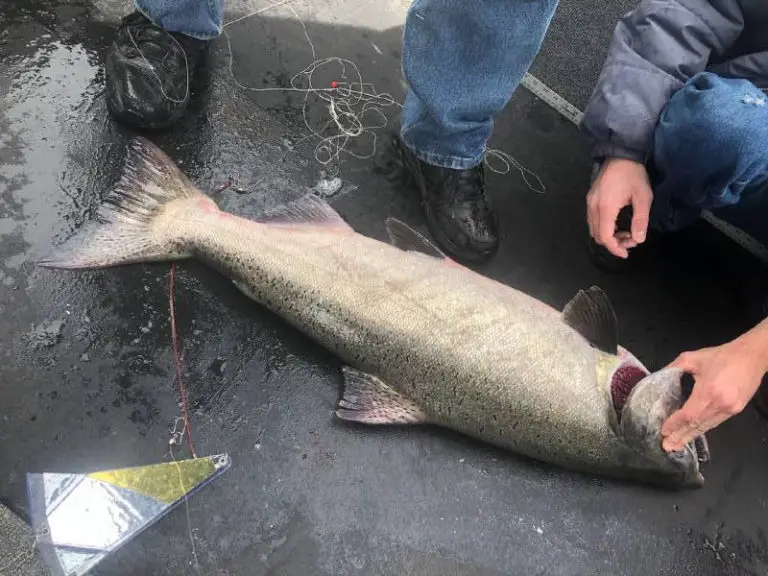As an avid angler in the Pacific Northwest, one of the key skills is being able to identify different salmon species One of the most common yet often misunderstood salmon is the tule salmon. Tule salmon are prevalent in many waterways, yet their undesirable flavor and texture makes them less popular among anglers However, with the right knowledge, tule salmon can be easily identified and released to ensure only prime salmon make it to the dinner table. In this article, we’ll explore some tips on how to identify a tule salmon.
What are Tule Salmon?
Tule salmon, also known as Columbia River chinook salmon, are a subspecies of chinook salmon that originate and spawn in the lower Columbia River. They get their name from the tule reeds that line the shallow waters of the Columbia. Tules are genetically close to other chinook salmon but have key physical differences that make them distinguishable to a trained eye. During spawning migrations, tules will swim 900 miles from the Pacific Ocean back to their natal spawning grounds in the Columbia River basin.
While edible, tule salmon are known for having soft, oily flesh that some find less desirable compared to other salmon species like coho and sockeye. Their taste and texture is a result of their longer migration and time spent in freshwater before spawning.
Identifying Characteristics of Tule Salmon
When trying to identify a tule salmon there are a few key characteristics to look for
-
Body Shape – Tules tend to have a short, stocky body shape in proportion to their length. Their body may be as wide or wider than other salmon species yet shorter in length. They lack the long, torpedo-shaped profile of salmon like king and coho.
-
Head Size – A tule’s head is disproportionately large for its body size. Males in particular tend to have distinctly large heads.
-
Spotting – Tules are covered in large, irregularly shaped black spots on their back and tail. The spots are more pronounced and denser than other salmon.
-
Tail Shape – The tail fins on tule salmon tend to be more squared off than pointed.
-
Color – Tule salmon range in color from olive green to grayish brown. Bright chrome colored salmon are less likely to be tules.
-
Adipose Fin – Tules often have a larger adipose fin compared to other species.
-
Anal Fin – The anal fin on a tule also tends to be larger and more squared off compared to other salmon.
In general, tule salmon have a “rotund” shaped profile – short and stocky vs the more streamlined shape of salmon like coho and Chinook. Their tails are more squared than forked and their heads and fins are oversized for their body length. Once you train your eye to spot these characteristics, picking out a tule becomes much easier.
Tips for Identifying Tule Salmon
When trying to identify tule salmon, here are some useful tips:
-
Compare fish side by side when possible. Seeing the differences in body shape next to a leaner salmon makes them easier to distinguish.
-
Look for the large, distinct spots on the back and dorsal fin as an early indicator. Dense, splotchy spots are a hallmark.
-
Target the head, adipose fin, and anal fin as key identifiers. If they appear outsized for the length of the fish, it’s likely a tule.
-
Consider the water source. Tule salmon are most common in the Columbia River basin so it’s smart to be on high alert for them if fishing those waters.
-
Handle the fish. The soft, mushy texture of a tule is an instant giveaway once you have your hands on it.
-
Release any salmon you’re still unsure about. If it has some tule characteristics but you aren’t positive, let it swim to be safe.
Why Identify Tule Salmon?
For anglers hoping to take salmon home to eat, being able to correctly identify tule salmon is an important skill. Since many find their flavor inferior to other wild salmon, keeping them out of your catch means ending up with better-tasting fish on your dinner table. No one wants to get home after a long fishing trip only to find they unknowingly kept the low-quality fish.
However, identifying tule salmon isn’t just about avoiding their unfavorable meat. Releasing tules also helps protect their spawning populations which are under pressure. Preventing overharvest of these native fish helps preserve the health of the Columbia River system.
So while tule salmon may not be prized for eating, they play an important ecological role in their native waters. Knowing how to properly identify them keeps the rivers full of these unique fish for generations to come. With the right knowledge, picking out a tule salmon becomes quick and straightforward.

What The HECK Is A TULE?! (Salmon Fishing Tips)
FAQ
What is a tule salmon?
Tule Fall Chinook salmon are native to this part of the Columbia River and have historically provided food for people living along the river. Columbia River Indians called them mitula~, or “white salmon,” because the flesh of the salmon is light colored when they return to spawn.
What is the difference between Urb and Tule salmon?
The first thing that SCREAMS tule is the dense heavy spotting. Compare how the URB’s have such a sparse spot pattern. The next-most obvious feature is the overall body shape. Tules tend to be short for girth. That tule is as big or bigger around than the other four fish, yet it is clearly shorter than the rest.
How do you tell what salmon you have?
The most important way to tell silvers (coho) from kings (Chinook), is the gum line where the teeth come out. White = silver salmon, black = king salmon. Be careful and learn to ID or you could get a ticket since sometimes the limit is different for the two species.
